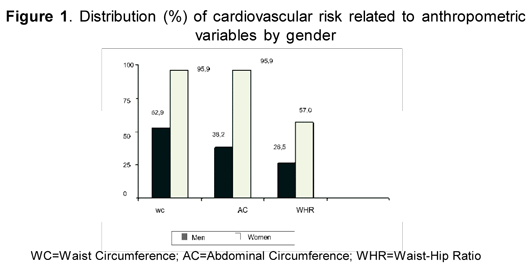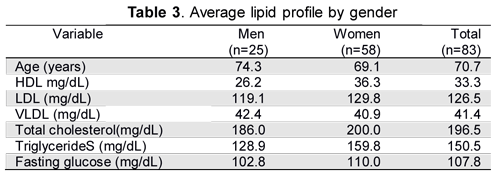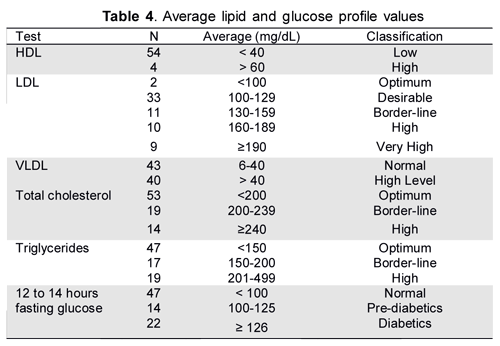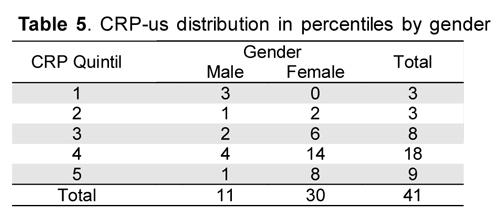Services on Demand
Journal
Article
Indicators
-
 Cited by SciELO
Cited by SciELO -
 Access statistics
Access statistics
Related links
-
 Cited by Google
Cited by Google -
 Similars in
SciELO
Similars in
SciELO -
 Similars in Google
Similars in Google
Share
Revista de Salud Pública
Print version ISSN 0124-0064
Rev. salud pública vol.13 no.3 Bogotá May/June 2011
Artículos Originales/Original Articles
The correlation between anthropometric measurements and biochemical cardiovascular risk markers in the hypertensive elderly
Correlación entre parámetros antropométricos y marcadores bioquímicos de riesgo cardiovascular en ancianos hipertensos
Asdrúbal Nóbrega Montenegro-Neto1, Mônica Oliveira da Silva-Simões1, Ana C. Dantas de Medeiros1, Alyne da Silva Portela1, Maria do Socorro Ramos de Queiroz1, Ramon Cunha-Montenegro2 and Maria Irany-Knackfuss3
1 Universidade Estadual da Paraíba-UEPB. Brasil. netotraducao@hotmail.com, moscg@uol.com.br, anacdmedeiros@yahoo.com.br, alyneportela@yahoo.com.br, queirozsocorroramos@yahoo.com.br,2 Centro Universitário de João Pessoa-UNJPÊ. Brasil. proframon@ig.com.br
3 Universidade Federal do Rio Grande do Norte-UFRN. Brasil. mik@ufrnet.br
Received 28th December 2010/Sent for Modification 20th May 2011/Accepted 3rd June 2011
ABSTRACT
Objectives This study was aimed at correlating anthropometric markers indicating additional cardiovascular risk in a hypertensive elderly population enrolled in the HIPERDIA programme in Campina Grande, Paraíba, Brazil, South America.
Methods The sample consisted of 131 hypertensive elderly people aged60 to 92 (25.9 % males and 74.1 % females). A socioeconomic, demographic, life-style questionnaire was used in the assessment. Information about anthropometry measurements and pathology frequency were also recorded via this questionnaire. Pearson's correlation, descriptive statistics, comparison between anthropometric variables by gender using Student's t-test and one-way ANOVA were used in the analysis for comparing groups by age(60 to 69, 70 to 79 and > 80 years).
Results 14.7 % of men and 24.7 % of women were overweight and 11.8 % of men and 21.6 % of women were obese. 57.0 % of women and 26.5 % of men had inadequate values in waist-to-hip ratio analysis. 95.9 % of women and 52.9 % of men had high risk and 95.9 % of women and 38.2 % of men had high abdominal circumference values regarding waistline measurement. After selection (n=40) for correcting potential confounders, it was found that 27 subjects had high C-reactive protein values, an additional cardiovascular risk factor.
Conclusions The results suggested that additional cardiovascular risk could be demonstrated by the high prevalence of being overweight and central obesity presented by the population and the presence of subclinical inflammation amongst hypertensive ones.
Key Words: Anthropometry, hypertension, nutritional status (source: MeSH, NLM).
RESUMEN
Objetivos El objetivo de este estudio fue correlacionar indicadores antropométricos de riesgo cardiovascular adicionales en una población de ancianos hipertensos registrados en el programa HIPERDIA, en Campiña Grande, Paraíba, Brasil, América del Sur.
Métodos La muestra contó con 131 ancianos hipertensos, de 60 a 92 años (25,9 % masculino y 74,1 % femenino). Se utilizaron antropometría y encuesta por medio de un cuestionario con informaciones socioeconómicas, demográficas, hábitos de vida, y frecuencia de las enfermedades. En el análisis fue utilizada la correlación de Pearson, estadística descriptiva y para la comparación de las variables antropométricas por sexo Test t de Student y ANOVA One-Way para comparación por edad: 60 a 69, 70 a 79 y > 80.
Resultados Los hombres presentaron frecuencias de 14,7 % de sobrepeso y 11,8 % de obesidad, y mujeres 24,7 % y 21,6 %, respectivamente. En el análisis de índice cintura-cadera, 57,0 % de las mujeres y 26,5 % de los hombres presentaron valores de riesgo. Analizando el perímetro de la cintura, 95,9 % de las mujeres y 52,9 % de los hombres presentaron riesgo, y 95,9 % de las mujeres y 38,2 % de los hombres presentaron elevados valores del perímetro abdominal. Despúes de una selección (n=40) para la corrección de posibles factores de confusión, 27 personas presentaron Proteína C Reactiva elevada.
Conclusiones Los resultados muestran riesgo cardiovascular adicional, que se demuestra por la alta frecuencia del sobrepeso y obesidad central que se presentan en la población, asociados a inflamación subclínica en hipertensos.
Palabras Clave: Antropometría, presión sanguínea, estado nutricional (fuente: DeCS, BIREME).
There are about 600 million hypertensive patients around the world according to the World Health Organization (WHO) in a report published in 2003(1-3). Brazilian Ministry of Health estimates have shown that the prevalence of hypertension is already high, accounting for 22.3 % to 43.9 % of the population aged over twenty in some cities (4).
Studies have shown that cardiovascular health risk assessment (usually done by determining Framingham cardiac risk scores) can be improved by measuring inflammation plasma markers and anthropometric evaluation (5-7). These markers include acute phase proteins, such as C-reactive protein (CRP) (6-7).Anthropometry is an effective method for ascertaining nutritional status (8,9); its variables have been reported in the literature as being important cardiovascular risk predictors (10,11).
HiperDia is a program which was created by the Brazilian Ministry of Health that enrolls hypertension and diabetes patients in all ambulatory clinics of the Sistema Único de Saúde-SUS.
Based on this context, this study aimed to correlate biochemical markers (total cholesterol and CRP) with anthropometric measures, indicators of additional cardiovascular risk in a population of elderly hypertensive patients.
MATERIAL AND METHODS
This was a population-based quantitative study using a non-probability intentional sample. The population consisted of 100 % hypertensive elderly (n=4 108) aged over 60who were enrolled in the HiperDia program in Campina Grande, Paraíba, Brazil, from February 2007 to December 2008; the sample consisted of 131 elderly people aged over 60 (n=131) who were enrolled in HiperDia registered in the main SUS health unit in Campina Grande.
Data was collected from February 2007 to December 2008 on Monday and Tuesday mornings from 8 to 11 am and on Tuesday afternoons from 1 to 4 pm(when the service operated in three stages).
The first stage consisted of research with participants via form-filling to obtain data about socio-economic level, lifestyle and prevalence of diseases, evaluation of blood pressure and anthropometric measurements.
Regular participants who performed any kind of regular physical activity(at least 3 times a week) for a minimum of 30 minutes daily were considered to be physically active. Participants who did not practice any regular form of physical activity were considered sedentary (12).
Income was defined as the sum of all family income divided by the number of people residing in a particular dwelling.
Educational level was defined as being the number of years spent studying in regular schools. Lifestyle information contained information about whether tobacco and/or alcohol were used, together with their frequency in years.
The second phase involved collecting blood for lipid and glucose determination; this was sent to the UEPB Clinical Analysis Laboratory during the same period.
Blood pressure was measured twice using each patient's right arm when they were in a sitting position following at least five minutes rest; hypertensive subjects had >140 mean systolic blood pressure (MSBP) and >90 mmHg mean diastolic blood pressure (MDBP)(2) measured by a calibrated aneroid sphygmomanometer(Mark Wan Med) and stethoscope (Littmann).
Subjects were without shoes and coats, wearing only light clothing, upright, with feet together when anthropometric measurements were taken using the techniques proposed by De Groot (13) and Lohman (14).
The following indicators were evaluated.
• Body mass index (BMI), using the cutoff values proposed by the Pan-American Health Organization (PAHO) used in Health Welfare and Aging (HWA) research: < 23 kg/m² low weight, 23-27.99 kilograms/m² normal weight, 28 to 29.99 kg/m² being overweight and > 30 kg/m² (15)being obese;
• Measurements were taken using a150 kg capacity electronic digital scale (Tanita VM-080), varying from 100g, affixed tape-measure (Sanny) and 220 cm capacity SEA - 206 stadiometer;
• Waist-hip ratio (WHR), female subjects being considered as suffering central obesity who had > 0.85 WHR and males who had > 1.0 WHR (13,14);
• Waist circumference (AC), males having greater than 102 cm measurement being considered at risk for metabolic and cardiovascular diseases as were females measuring more than 88 cm (13,14); and
• Abdominal circumference (WC), considering > 94 cm as reference indicating risk values for men and > 80 cm for women (13,14).
The lipid profile was analysed in accordance with the Brazilian Society of Cardiology's (BSC) 4th Brazilian Guidelines on Dyslipidaemia (16), blood being collected after a minimumof 12 hours fasting, calculated by the Friedewald method (16).
Individuals who had >126 mg/dl fasting plasma glucoseon two occasionswere considered as being diabetic. The colorimetric method was used for determining blood glucose after at least a minimum of 12 hours fasting (17).
The third phase consisted of collecting blood for serum high-sensitivity CRP (hs-CRP). This was preceded by individuals who only had hypertension being pre-selected who were then invited to take the examination. Blood samples were sent for analysis to the Hermes Pardini Institute in Belo Horizonte, Minas Gerais state, Brazil, during the same period.
Nephelometry was used for analysis; subjects having hs-CRP values above the 3rd quintile (1,2-1,9 mg/dL) according to BSC were regarded as being at increased cardiovascular risk (16).
Statistical analysis
The Kolmogorov-Smirnov test was carried out in 2 steps(p<0.05 significance).
Two groups (male and female) were formed during the first step which compared anthropometric variables. Mean BMI, AC and WHR were compared by gender using Student's t-test.
Three groups of participants were then formed to compare the influence of age on anthropometric variables: group 1 (aged 60 to 69), group 2 (70 to 79) and group 3 (> 80);one-way ANOVA was then performed.
Pearson's correlation test (r) was used in the second stage for identifying the correlation between anthropometric and biochemical variables.
Elderly patients who only had arterial hypertension were selected to minimize the influence of confounding factors on hs-CRP values, following Ford's recommendations (6). hs-CRP values were not recorded for those who were classified as being overweight or obese, who had had diabetes, arthritis and any inflammatory and/or infection during the two weeks prior to the blood tests.
Results having p <0.05 were considered as being statistically significant.
RESULTS
Age stratification by gender(population n=4,108: 1,399 men, 2,709 women) revealed 672 malesaged 60-69, 488 aged 70-79 and 239 aged over 80 and 1,408 females aged 60-69,887 aged 70-79 and 414 aged 80 or over; data was found on the HiperDia system (17).
25.9 % of participants in the sample were male and 74.1 % female (n=131). Age ranged from 60 to 92 years (average 71). Monthly family income for the group being studied ranged from 32.05 to 800.00 $ Reais per person (average 268.85 $ Reais).
Regarding disease type, 73.5 % were hypertensive, 26.5 % diabetic and hypertensive but none of them were exclusively diabetic. Knowing that the whole population was receiving pharmacological treatment for hypertension, mean systolic blood pressure for men was 123.3 mm Hg and 133.4 mm Hg for women; mean diastolic pressure for men was 76.7 mm Hg and 80.2 mm Hg for women.
Concerning living habits, 94.7 % of the elderly stated that they did not smoke (individuals who reported having stopped smoking for at least one year being considered non-smokers), 98.5 % had not used alcohol for over a year and 75.8 % did not exercise regularly.
There was a high prevalence of obesity and being overweight in both elderly genders since 14.5 % were underweight, 44.3 % had normal weight, 22.1 % were overweight and 19.1 % were obese. Underweight prevalence was 20.6 % in males and 12.4v % in females; 14.7 % of men and 24.7 % of women were overweight and 11.8 % of men and 21.6 % of women were obese (Table 1).

Student's t-test was used for comparing averages by gender. An average 25.8 (3.3 SD) BMI was found for males and 27.5 for females (3.6 SD), the difference being statistically significant between genders (p=0.0143). An average 96 cm (10.9 SD) was obtained for WC in men and 94.7 (9.9 SD) average for women (no statistically significant difference between genders, p=0.5206).
Figure 1 shows that 95.9 % of women showed increased cardiovascular risk concerning WC. The percentage of men at high risk (52.9 %) was much lower.

Figure 1 shows that 95.9 % of women had risk-indicating values regarding AC (compared to 38.2 % for men). Compared by gender, men's average AC was 99.4 cm (10.9 SD) and 102.4 cm for women (9.7 SD), indicating no statistically significant difference between genders (p=0.1258).
WHR analysis revealed that 57.0 % of women and 26.5 % of men had values equal to or above the recommended level (Figure 1). Overall average WHR for men was 0.94 (0.06 SD) and 0.90 for women (0.07 SD) indicating differences between genders.
The elderly were divided into 3 groups by age in variance analysis:60 to 69 (n=59), 70 to 79 (n=58) and > 80 (n=14).
WHR revealed statistically significant difference (p=0.0418) regarding age-group 1 compared to the others (Table 2),but there were no significant differences for BMI, AC and WC (p<0.05).

After anthropometric data had been collected, all subjects were asked to take a blood test for determining lipid profile; however, it was only assessed in 83 participants. This data is shown as averages in Table 3.

The suitability of the average values obtained in this study was verified in individuals aged >20 years based on BSC (4), lipids and 12 to 14 hour fasting plasma glucose (Table 4).

Hs-CRP was evaluated in 41 subjects(11 males and 30 females) who were selected following this study's criteria for eliminating confounding factors (Table 5).

Hs-CRP statistically significant differences were verified regarding gender, i.e. 1.9 average for males and 3.2 for females (p=0.03). Twenty-seven subjects had values above the 3rd population distribution quintile, 18 above the 4th quintile and 9 above the 5th quintile.
Pearson's test was used for correlation between hypertensive individuals' hs-CRP, lipid profile and anthropometry. Individuals were selected to exclude the confounding factors mentioned in this study's methodology (n=41).
It was found that average BMI, WC and AC were positively associated (r=0.7; p<0.001); the higher the BMI, the greater the WC.
BMI also had even stronger positive correlation with average Hip circumference-HC (r=0.8; p<0.001).
Correlation test results (Pearson's r values ranging from 0.00 to 0.19) indicated poor association between hs-CRP and lipid profile and the anthropometric measurements evaluated in this study.
DISCUSSION
6,682 hypertensive patients were enrolled in the program in Campina Grande while this research lasted, this being the second most populous city in Paraíba (17).
Multiplicity and interaction between various cardiovascular risk factors may be involved in many diseases' development and progression (18,19).
Despite low smoking and alcohol prevalence (both being 5.3 %), this sample had high rates of physical inactivity (75.8 %);according to Siqueira (20), the latter is above average in the north-eastern region of Brazil (58.0 %).
No significant differenceswere found regarding the prevalence of obesity in the 60-69, 70-79 and > 80age-groups. However, Abrantes' study (21) observed that obesity has become significantly higher amongst females (2.6 %), reaching almost twice that for males (1.8 %).
WC analysis found that gender and not age had a significant influence on this variable. Women were in the majority in this study (74.1 %) and 95.9 % of them had measurements indicative of increased cardiovascular risk, compared to 52.9 % for men. This contradicted the literature which states that central obesity is more common amongst men (22). It should be emphasized that the fat distribution pattern could have been associated with the long and healthy life pattern presented by the men is this sample.
Only WHR had a statistically significant difference regarding age (p=0.0418) and gender (p=0.0046).
90.6 % of the women studied had the recommended > AC amount whilst 26.7 % of men had high values. The pattern of body fat distribution is important because the accumulation of abdominal fat has a close relationship with metabolic and cardiovascular diseases, such as diabetes mellitus and hypertension, respectively (23).
The population did not present a high risk in the lipid profile test, averages being considered reasonable by BSC (16).
However, as already discussed, anthropometric averages were above those recommended in the literature, indicating the additional cardiovascular risk promoted by hypertension in the studied population (14,21-23).
The correlations between hs-CRP and lipid profile performed after rigid control of confounding variables (6) were considered weak. Knowing that CRP is an independent risk factor for cardiovascular disease, it was emphasized, as in Ford (6) and Mendall (24), the importance of hs-CRP and anthropometry (25) in improving cardiovascular risk stratification.
Regarding CRP correlation with anthropometric variables, these were also regarded as weak but, because they have not been widely studied, no data was found in the literature for comparison for this age group.
Considering hs-CRP as an independent cardiovascular risk factor, and the strict control applied in selecting a homogeneous sample, this sample presented an additional risk for future cardiovascular events (6).
The participants had an average of 3years spent studying. Such low educational level, as also stated by Cavalini (26), may have influenced treatment of hypertension in the elderly since it hinders understanding drug prescription and treatment compliance.
The low average monthly income of only 268.85 $ Reais per person may have negatively influenced treatment (26).
The high prevalence of being overweight and suffering central obesity and the high sub-clinical inflammation rather present additional cardiovascular risks for individuals already affected by hypertension.
Even with lipid profile values and anthropometric measurements considered normal, some individuals were at increased cardiovascular risk, which was demonstrated by measuring hs-CRP levels.
It was hypothesized that a full assessment of cardiovascular risk in an elderly hypertensive population must include lipid profile, anthropometry and CRP in order to improve cardiovascular risk stratification.
REFERENCES
1. Wong LLR, Carvalho JA. The rapid process of aging in Brazil: serious challenges for public policies.R. Bras. Est. Pop. 2006; 23(1):5-26. [ Links ]
2. Chobanian AV, Bakris GL, Black HR, Cushman WC, Green LA, Izzo JL, et al. Seventh Report of the Joint National Committee on Prevention, Detection, Evaluation, and Treatment of High Blood Pressure. Hypertension. 2003; 42(6): 1206-52. [ Links ]
3. Kearney PM, Whelton M, Reynolds K, Muntner P, Whelton PK, He J. Global burden of hypertension: analysis of worldwide data. Lancet 2005; 365(9455): 217-23. [ Links ]
4. V Diretrizes Brasileiras de Hipertensão Arterial. ArqBrasCardiol. 2007; 89(3): e24-e79. [ Links ]
5. Rosini N, Machado MJ, Xavier HT. Study of the prevalence and multiplicity of cardiovascular risk factors in hypertensive individuals from the city of Brusque, SC, Brazil. Arq Bras Cardiol. 2006; 86(3):219-222. [ Links ]
6. Ford ES. Does exercise reduce inflammation? physical activity and C-Reactive Protein among U.S. adults. Epidemiology. 2002; 13(5): 561-568. [ Links ]
7. Fabijanic D, Banic M, Kardum D. C-reactive protein in cardiovascular risk evaluation.LijecVjesn2006; 128(5-6):167-74. [ Links ]
8. Litwin SE. Which Measures of Obesity Best Predict Cardiovascular Risk? J Am CollCardiol 2008; 52(8): 616-619. [ Links ]
9. Koh-banerjee P, Wang Y, Hu FB, Spiegelman D, Willett WC, Rimm EB. Changes in Body Weight and Body Fat Distribution as Risk Factors for Clinical Diabetes in US Men.Am J Epidemiol.2004; 159:1150-1159. [ Links ]
10. De Onis M, Habicht JP. Anthropometric reference data for international use: recommendations from a World Health Organization Expert Committee. Am J Clin Nutr. 1996; 64:650-8. [ Links ]
11. Barbosa AR, Souza JMP, Lebrão ML, Laurenti R, Marucci MFN. Anthropometry of elderly residents in the city of São Paulo, Brazil.Cad Saúde Pública. 2005; 21(6):1929-1938. [ Links ]
12. Bomam K, Olofsson M, Dahlõf B, GerdtsE, Nieminen MS, Papademetriou V et al. Left ventricular structure and function in sedentary and physically active subjects with left ventricular hypertrophy (the Life Study). Am J Cardiol. 2005; 95:280-3. [ Links ]
13. De Groot LC, Sette S, Zajkas G, Carbajal A, Amorim JA. Euronut SENECA investigators. Nutritional status: anthropometry. Eur J ClinNutr. 1991; 45 (s3):31-42. [ Links ]
14. Callaway CW, Chumlea WC, Bouchard C, Himes JH, Lohman TG, Martin AD, et al. "Circunferences". In: Lohman TG, Roche AF, Martorel R (Editors). Anthropometric standardization reference manual. Champaign: Human Kinetics Books ed.; 1988. pp 39-54. [ Links ]
15. Lebrão ML, Laurenti R. Health, well-being and aging: the SABE study in São Paulo, Brazil. Rev Bras Epidemiol. 2005; 8(2):127-141. [ Links ]
16. IV Brazilian Guidelines in Arterial Hypertension.Arq Bras Cardiol. 2007; 88(S1):2-18. [ Links ]
17. Departamento de Informática do SUS [Internet]. Sistema de Gestão Clínica de Hipertensão Arterial e Diabetes Mellitus da Atenção Básica. Disponible en: http://hiperdia.datasus.gov.br/. Consultado Agosto del 2010. [ Links ]
18. The Expert Committee on the Diagnosis and Classification of Diabetes Mellitus. Follow-up report on the diagnosis of diabetes mellitus.Diabetes Care. 2003: 26(11):3160-7. [ Links ]
19. Polanczyk CA. Cardiovascular Risk Factors in Brazil: The Next 50 Years. Arq.Bras Cardiol. 2005; 84(3):199-201. [ Links ]
20. Siqueira FV, Facchini LA, Piccini RX, Tomasi E, ThuméE, Silveira DS, et al. Physical activity in young adults and the elderly in areas covered by primary health care units in municipalities in the South and Northeast of Brazil. Cad SaúdePública. 2008; 24(1):39-54. [ Links ]
21. Abrantes MM, Lamounier JA, Colosimo EA. Overweight and obesity prevalence in Northeast and Southeast Regions of Brazil. Rev Assoc Méd Bras. 2003:49:2. [ Links ]
22. Lakka HM, Lakka TA, Tuomilehto J. Abdominal obesity is associated with increased risk of acute coronary events in men. Eur Heart. J 2002; 23:706-13. [ Links ]
23. Navarro AM, Stedille MS, Unamuno MRDL, Marchini JS. Body fat distribution in patients with and without chronic-degenerative diseases: use of the waist to hip relationship and arm fat index. Rev Nutr. 2001; 14(1):37-41. [ Links ]
24. Mendall MA, Patel P, Ballam L, Strachan D, Northfield TC. C Reactive protein and its relation to cardiovascular risk factors: a population based cross sectional study. BMJ 1996; 312:1061-1065. [ Links ]
25. Montenegro Neto AN, Simões MOS, Medeiros ACD, Protela AS, Dantas PMS, Knackfuss MI. Altered nutritional status and its association with lipid profile and lifestyle in hypertensive elders. Arch LatinoamerNutr. 2008; 58:350-356. [ Links ]
26. Cavalini LT, Chor D.A survey on hypertension andcognitive deficit in elderly subjects ina geriatric unit. Rev Bras Epidemiol. 2003;6(1):7-17. [ Links ]














